Optical Sensing of the Fatigue Damage State of CFRP under Realistic Aeronautical Load Sequences
Abstract
:1. Introduction

2. Materials and Methodology
2.1. Materials and Test Set up
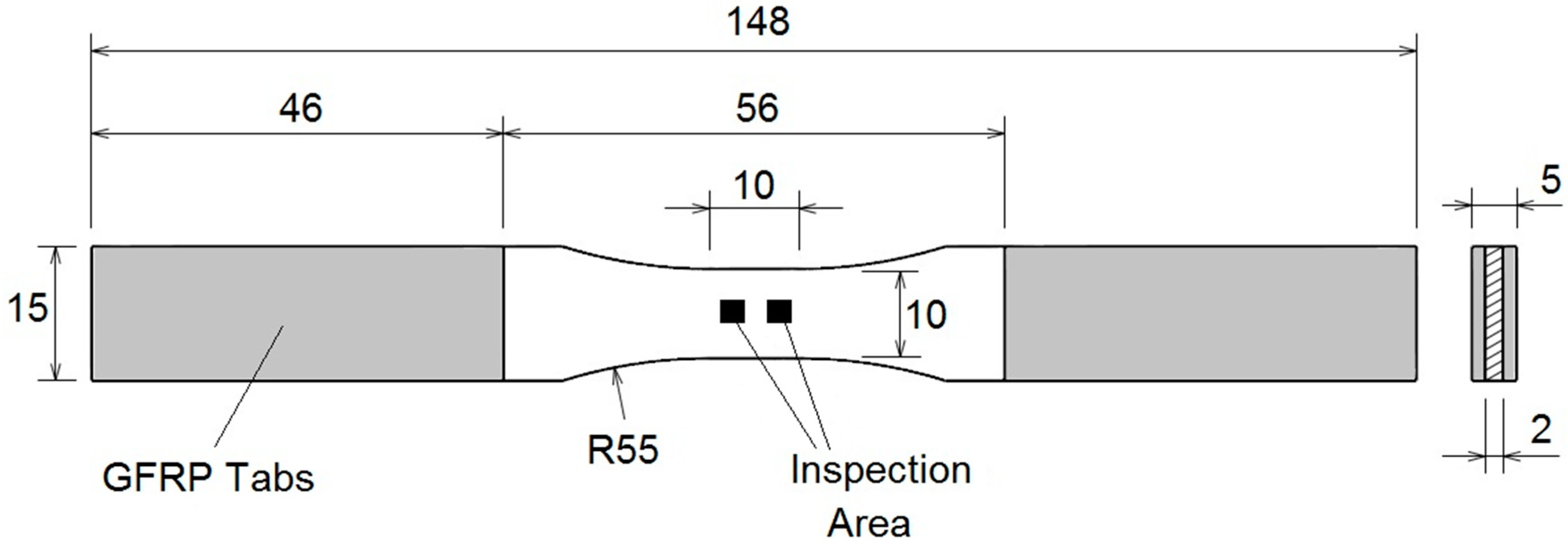
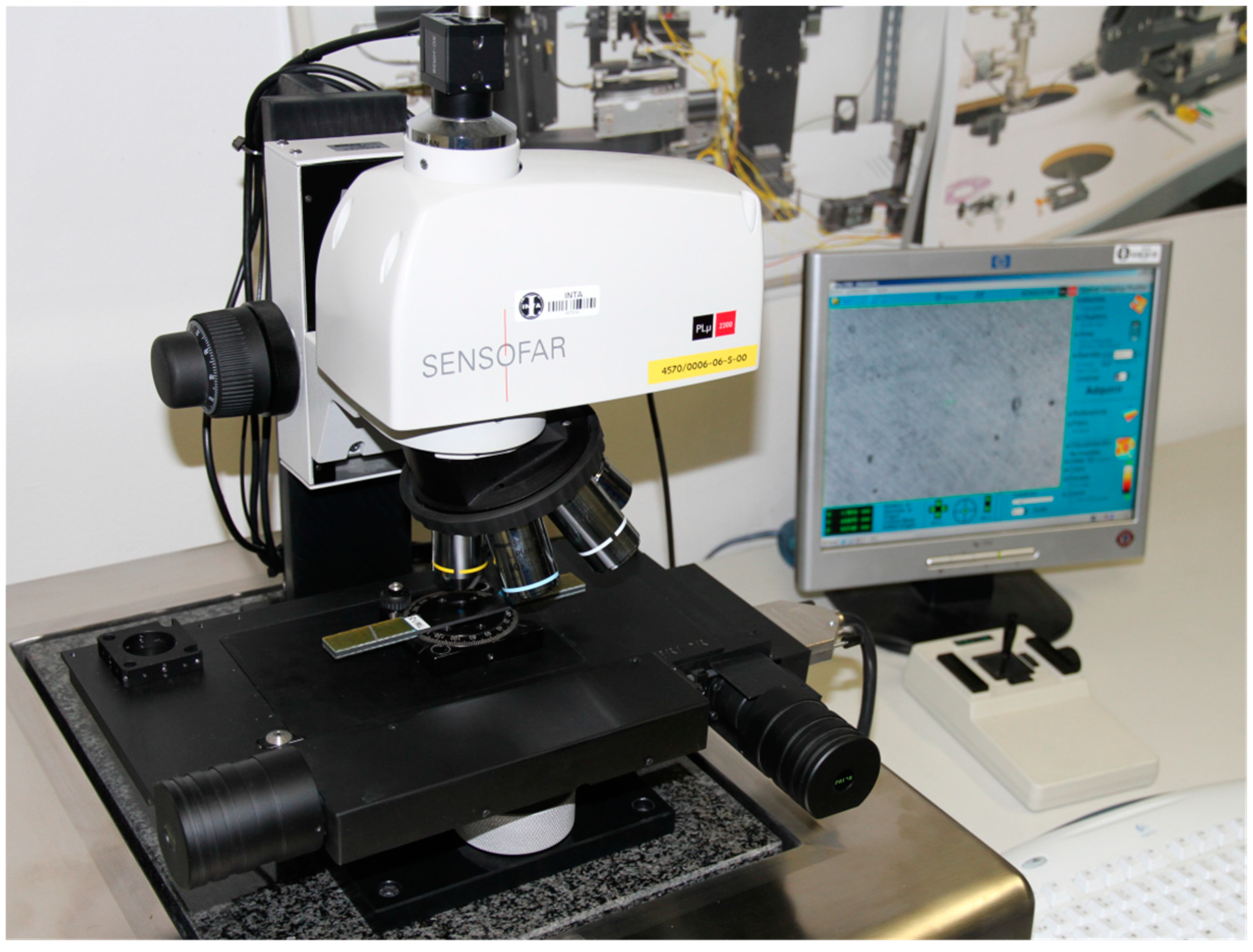
2.2. Fatigue Tests with Variable Amplitude Loads
| Coupon | Max Peak (%Sut) | Min Valley (%Sut) |
|---|---|---|
| C01 | 80% | 8% |
| C02 | 80% | 8% |
| C03 | 75% | 8% |
| C04 | 75% | 8% |
| C05 | 70% | 7% |
| C06 | 70% | 7% |
| C07 | 65% | 7% |
| C08 | 65% | 7% |
| C09 | 60% | 6% |

2.3. Surface Inspection by Confocal Microscope
3. Results and Discussion
3.1. Gassner Curve and Stiffness Degradation
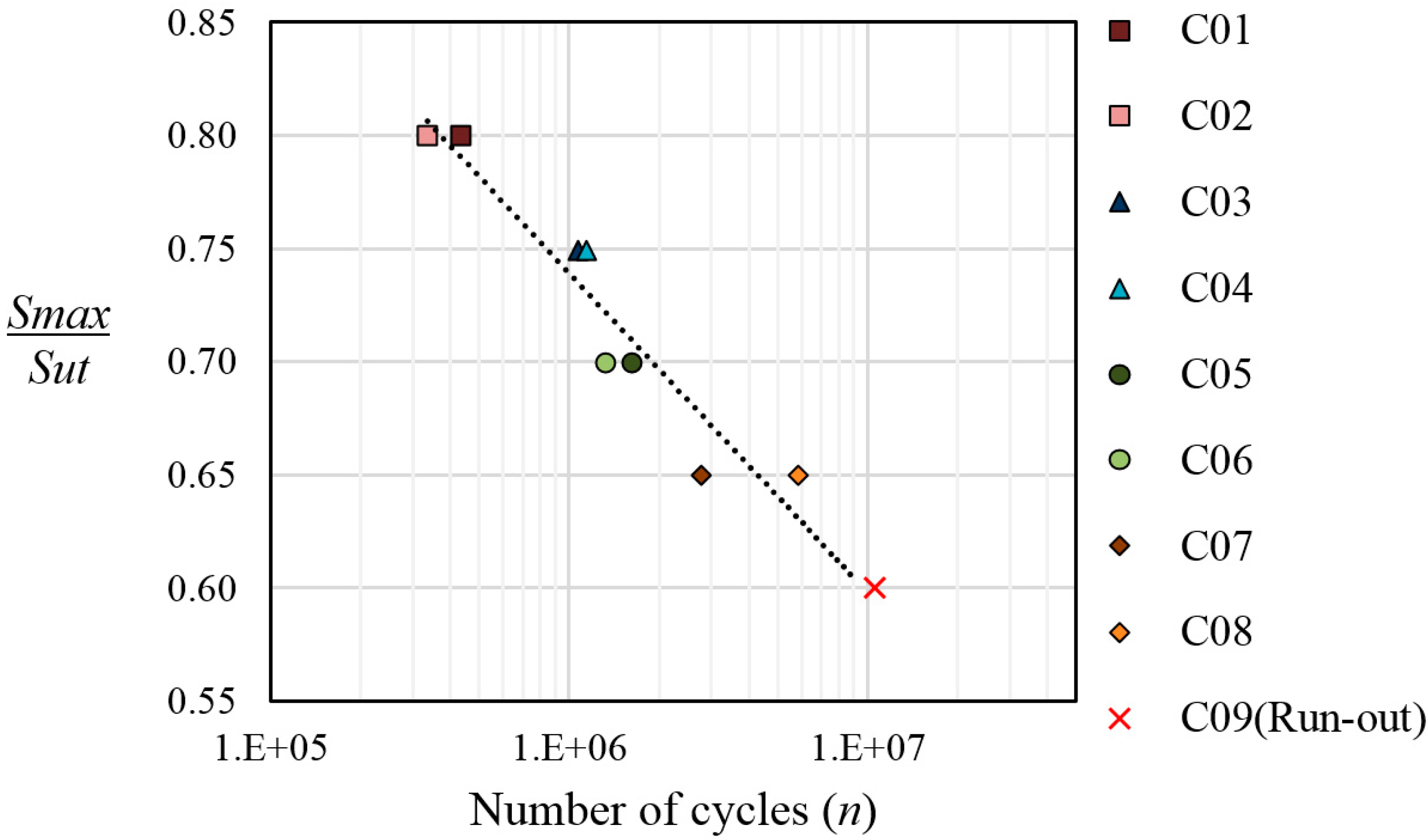
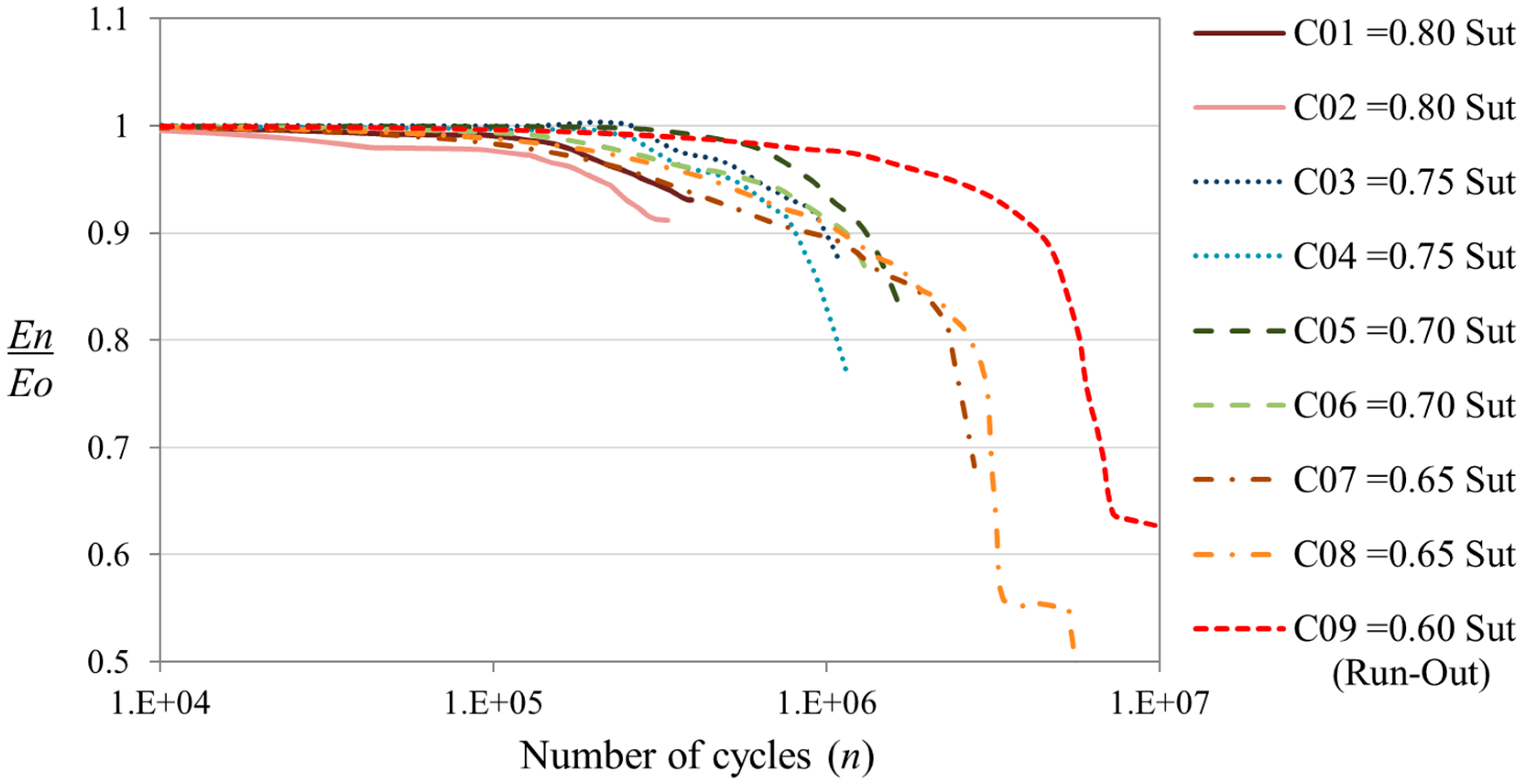
3.2. Surface Roughness Evolution through Cycles
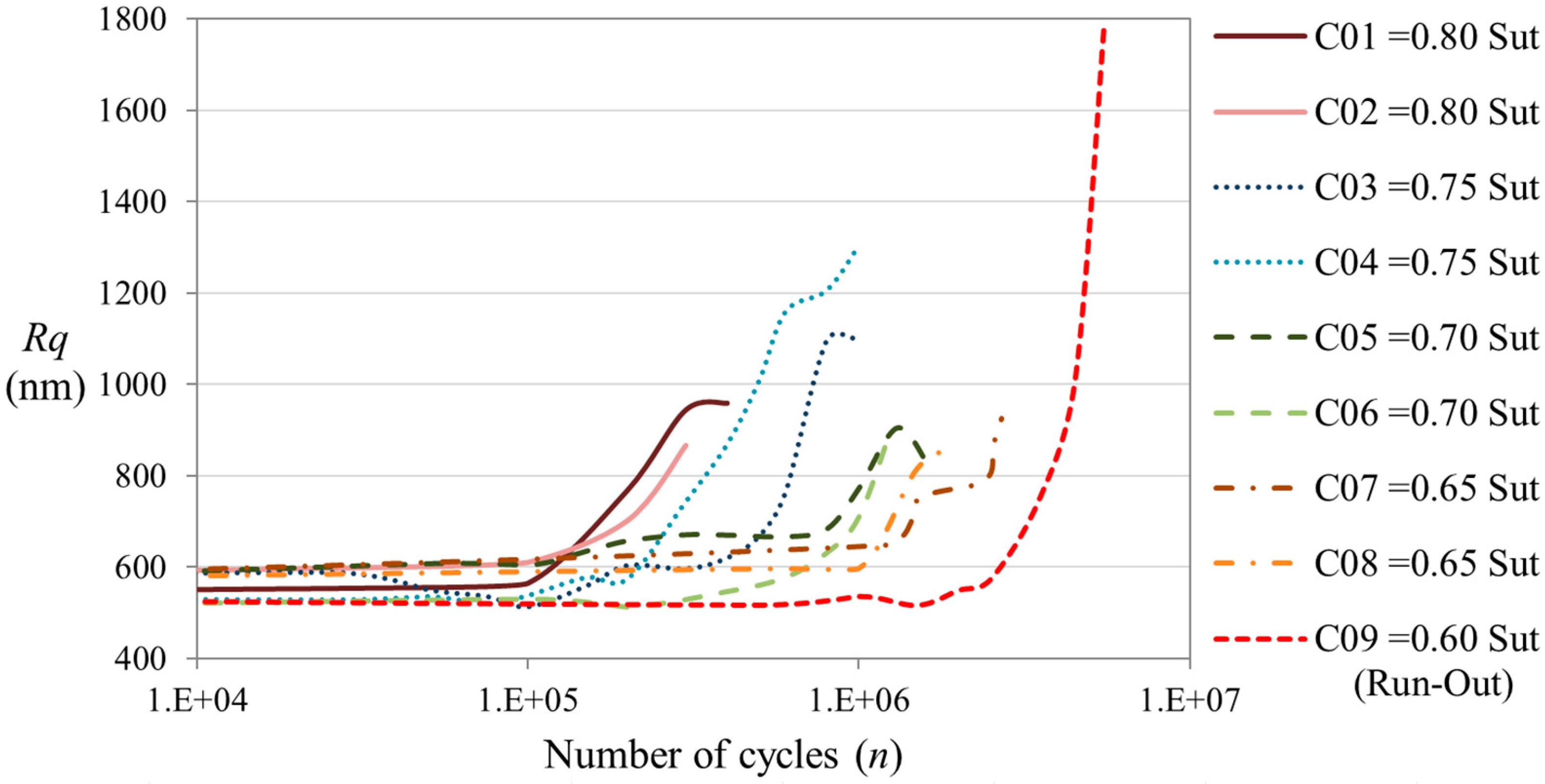
3.3. Surface Roughness versus Stiffness Degradation
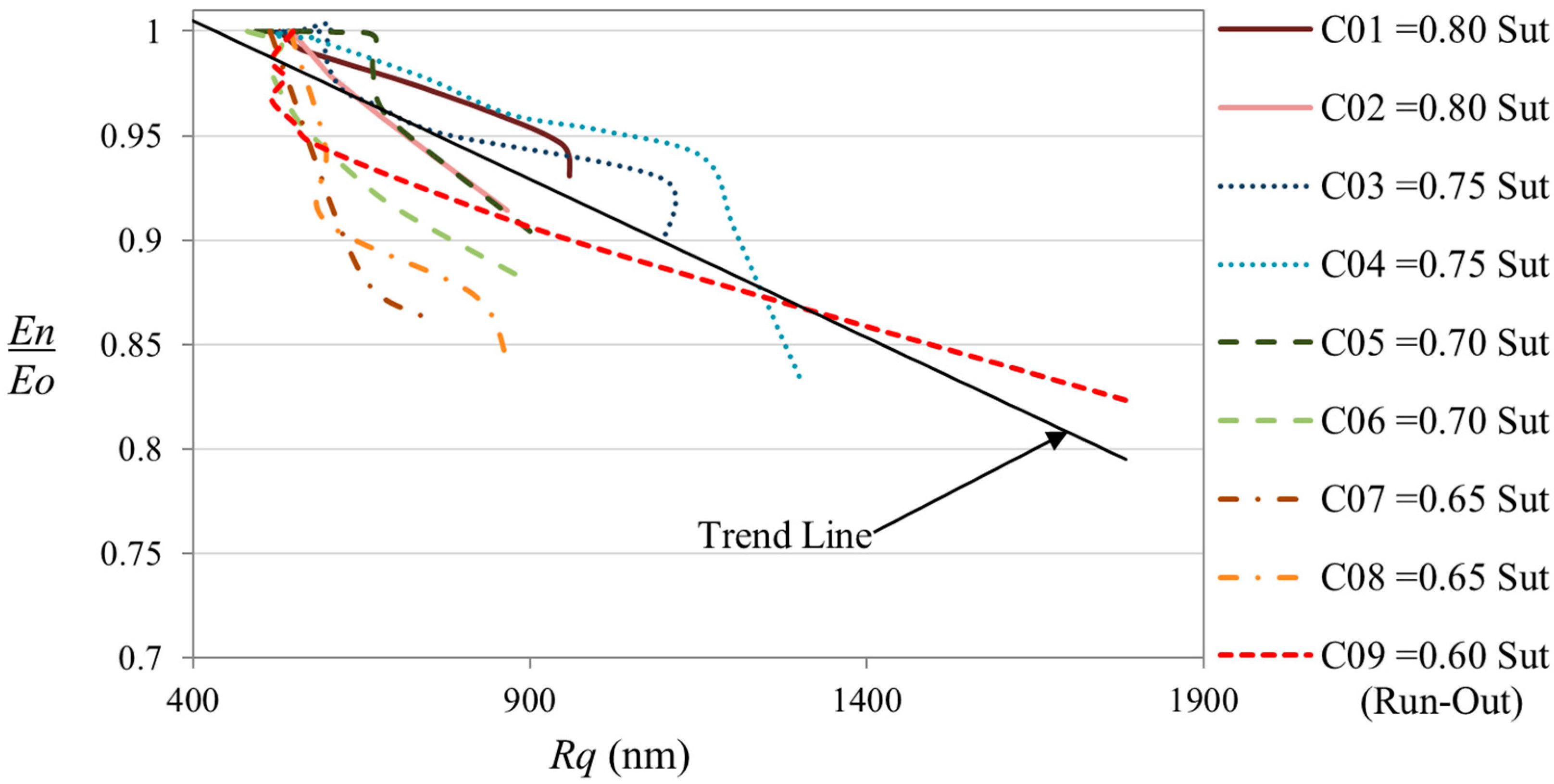
3.4. Comparison between Results Obtained in Previous Studies for CALs and the Results Obtained for VALs
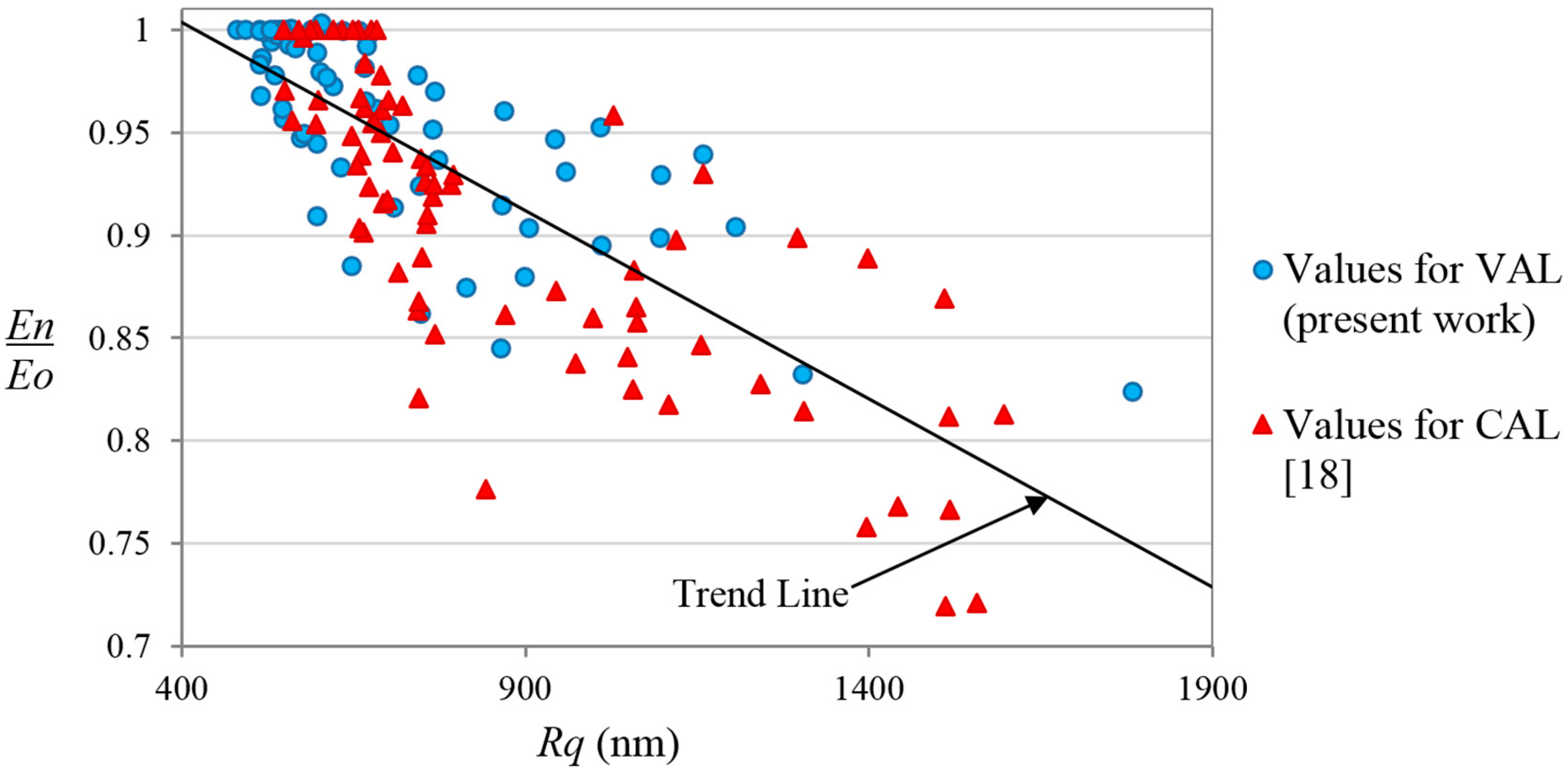
4. Conclusions
Acknowledgments
Author Contributions
Nomenclature
- CFRP = Carbon Fiber Reinforced Polymer
- GFRP = Glass Fiber Reinforced Polymer
- VAL = Variable Amplitude Load
- CAL = Constant Amplitude Load
- Sut = Ultimate Tensile Strength
- Smax = Maximum peak stress during the load history
- FALSTAFF = Fighter Aircraft Loading STAndard for Fatigue
- n = Number of cycles
- N = Number of cycles at failure also known as life.
- R = Stress Ratio (Smin/Smax)
- Rq = Roughness parameter which represents the root mean square of the heights
- P = Total number of pixels measured in an area of evaluation
- zi = height of the measured point “i” respect to the mean plane of the surface
- En/Eo = normalized stiffness degradation at cycle n
- Eo = Initial stiffness
- En = Stiffness at cycle n
- S-N = Stress vs Life curve
Conflicts of Interest
References
- Baker, A.; Dutton, S.; Kelly, D. Composite Materials for Aircraft Structures, 2nd ed.; AIAA: Reston, VA, USA, 2004. [Google Scholar]
- Boller, C.; Staszewski, W. Aircraft Structural Health and Usage Monitoring. In Health Monitoring of Aerospace Structures: Smart Sensors Technologies and Signal Processing; Staszewski, W., Boller, C., Tomlinson, G., Eds.; John Wiley & Sons Ltd: West Sussex, UK, 2004; pp. 29–74. [Google Scholar]
- Sonsino, C.M. Fatigue testing under variable amplitude loading. Int. J. Fatigue 2007, 29, 1080–1089. [Google Scholar]
- Post, N.L.; Case, S.W.; Lesko, J.J. Modeling the variable amplitude fatigue of composite materials: A review and evaluation of the state of the art for spectrum loading. Int. J. Fatigue 2008, 30, 2064–2086. [Google Scholar] [CrossRef]
- Epaarachchi, J.A. A study on estimation of damage accumulation of glass fibre reinforce plastic (GFRP) composites under a block loading situation. Compos. Struct. 2006, 75, 88–92. [Google Scholar] [CrossRef]
- Zuluaga-Ramírez, P.; Frövel, M.; Arconada, Á.; Belenguer, T.; Salazar, F. Evaluation of the Fatigue Linear Damage Accumulation Rule for Aeronautical CFRP Using Artificial Neural Networks. Adv. Mater. Res. 2014, 1016, 8–13. [Google Scholar] [CrossRef]
- Highsmith, A.L.; Reifsnider, K.L. Stiffness reduction mechanisms in composite laminates. In Damage of Composite Materials, ASTM STP 775; Reifsnider, K.L., Ed.; American Society for Testing and Materials: Philadelphia, PA, USA, 1982; pp. 103–117. [Google Scholar]
- Whitworth, H.A. A stiffness degradation model for composite laminates under fatigue loading. Compos. Struct. 1997, 40, 95–101. [Google Scholar] [CrossRef]
- Van Paepegem, W.; Degrieck, J. Coupled residual stiffness and strength model for fatigue of fibre-reinforced composite materials. Compos. Sci. Technol. 2002, 62, 687–696. [Google Scholar]
- Adden, S.; Pfleiderer, K.; Solodov, I.; Horst, P.; Busse, G. Characterization of stiffness degradation caused by fatigue damage in textile composites using circumferential plate acoustic waves. Compos. Sci. Technol. 2008, 68, 1616–1623. [Google Scholar] [CrossRef]
- Dzenis, Y.A. Cycle-based analysis of damage and failure in advanced composites under fatigue: 1. Experimental observation of damage development within loading cycles. Int. J. Fatigue 2003, 25, 499–510. [Google Scholar] [CrossRef]
- Ahsan, M.; Han, X.; Islam, S.; Newaz, G. Fatigue damage detection in graphite/epoxy composites using sonic infrared imaging technique. Compos. Sci. Technol. 2004, 64, 657–666. [Google Scholar] [CrossRef]
- Dattoma, V.; Giancane, S. Evaluation of energy of fatigue damage into GFRC through digital image correlation and thermography. Compos. Part B Eng. 2013, 47, 283–289. [Google Scholar] [CrossRef]
- Wang, X.; Chung, D.D.L. Self-monitoring of fatigue damage and dynamic strain in carbon fiber polymer-matrix composite. Compos. Part B: Eng. 1998, 29, 63–73. [Google Scholar] [CrossRef]
- Giancane, S.; Panella, F.W.; Nobile, R.; Dattoma, V. Fatigue damage evolution of fiber reinforced composites with digital image correlation analysis. Procedia Eng. 2010, 2, 1307–1315. [Google Scholar] [CrossRef]
- Withers, P.J.; Preuss, M. Fatigue and damage in structural materials studied by X-ray tomography. Annu. Rev. Mater. Res. 2012, 42, 81–103. [Google Scholar] [CrossRef]
- Zuluaga, P.; Frövel, M.; Restrepo, R.; Trallero, R.; Atienza, R.; Pintado, J.M.; Belenguer, T.; Salazar, F. Consumed Fatigue Life Assessment of Composite Material Structures by Optical Surface Roughness Inspection. Key Eng. Mater. 2013, 569–570, 88–95. [Google Scholar] [CrossRef]
- Zuluaga-Ramírez, P.; Frövel, M.; Belenguer, T.; Salazar, F. Non contact inspection of the fatigue damage state of carbon fiber reinforced polymer by optical surface roughness measurements. NDT E Int. 2015, 70, 22–28. [Google Scholar] [CrossRef] [Green Version]
- Bhushan, B. Surface Roughness Analysis and Measurement Techniques. In Modern Tribology Handbook; Bhushan, B., Ed.; CRC Press: Boca Raton, FL, USA, 2000; Volume 1, pp. 49–120. [Google Scholar]
- UNE EN ISO 4287:1999. In Geometrical Product Specifications (GPS)—Surface Texture: Profile Method—Terms, Definitions and Surface Texture; AENOR: Madrid, Spain, 1999.
- Ruffing, B. Application of speckle-correlation methods to surface-roughness measurement: A theoretical study. J. Opt. Soc. Am. A 1986, 3, 1297–1304. [Google Scholar] [CrossRef]
- Salazar, F.; Belenguer, T.; García, J.; Ramos, G. On roughness measurement by angular speckle correlation. Metrol. Measur. Syst. 2012, 19, 373–380. [Google Scholar]
- IHS ESDU 97018. In Standard Fatigue Loading Sequences; ESDU International plc: London, UK, 1999; pp. 5–13.
© 2015 by the authors; licensee MDPI, Basel, Switzerland. This article is an open access article distributed under the terms and conditions of the Creative Commons Attribution license (http://creativecommons.org/licenses/by/4.0/).
Share and Cite
Zuluaga-Ramírez, P.; Arconada, Á.; Frövel, M.; Belenguer, T.; Salazar, F. Optical Sensing of the Fatigue Damage State of CFRP under Realistic Aeronautical Load Sequences. Sensors 2015, 15, 5710-5721. https://doi.org/10.3390/s150305710
Zuluaga-Ramírez P, Arconada Á, Frövel M, Belenguer T, Salazar F. Optical Sensing of the Fatigue Damage State of CFRP under Realistic Aeronautical Load Sequences. Sensors. 2015; 15(3):5710-5721. https://doi.org/10.3390/s150305710
Chicago/Turabian StyleZuluaga-Ramírez, Pablo, Álvaro Arconada, Malte Frövel, Tomás Belenguer, and Félix Salazar. 2015. "Optical Sensing of the Fatigue Damage State of CFRP under Realistic Aeronautical Load Sequences" Sensors 15, no. 3: 5710-5721. https://doi.org/10.3390/s150305710






